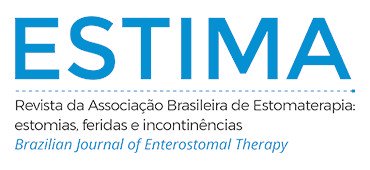SKIN TEARS IN THE ELDERLY
Abstract
Objectives: to identify in the scientific literature the knowledge produced about skin tears injuries in the elderly. Methods: it is an integrative literature review (2014-2019), carried out by searching the databases/platforms National Library of Medicine, Biomedical Answers and Biblioteca Virtual em Saúde, with descriptors and the Boolean operators “and” and “or ”. Results: from the bibliographic search, selection and analysis, eight articles made up the sample. For skin tears injuries in the elderly, four pillars of care emerged: maintenance of organic and tissue homeostasis with a focus on proper nutrition and hydration; avoid trauma to senile skin, providing a safe environment with suitable devices; and the systematization of health care and education for elderly skin care. Conclusion: as prevention mechanisms, primary prevention is achieved through a unique care plan and health education activities, focused on risk factors and vulnerabilities, minimizing damage and complications.
Downloads
Metrics
References
Miranda GMD, Mendes ACG, Silva AL. Population aging in Brazil: current and future social challenges and consequences. Rev Bras Geriatr Gerontol 2016;19(3):507-519. http://dx.doi.org/10.1590/1809-98232016019.150140
ONU. Organização das Nações Unidas. Mundo terá dois milhões de idosos em 2050: OMS diz que envelhecer bem deve ser prioridade global, 2014. Disponível em: http://nacoesunidas.org/mundo-tera-2-bilhoes-de-idosos-em-2050-oms-diz-queenvelhecer-bem-deve-ser-prioridade-global/
Lini EV, Portella MR, Doring M. Factors associated with the institutionalization of the elderly: a case-control study. Rev Bras Geriatr Gerontol 2016;19(6):1004-14. http://dx.doi.org/10.1590/1981-22562016019.160043
Freitas EV, Py L. Tratado de geriatria e gerontologia. 4ª Edição. Guanabara Koogan. Rio de Janeiro, 2017.
Carvalho TC, Valle AP do, Jacinto AF, Mayoral VF de S, Boas PJFV. Impact of hospitalization on the functional capacity of the elderly: A cohort study. Rev Bras Geriatr Gerontol 2018;21(2):134-42. http://dx.doi.org/10.1590/1981-22562018021.170143
Resolução de Diretoria Colegiada – RDC nº 283, de 26 de setembro de 2005. ANVISA – Agência Nacional de Vigilância Sanitária. Disponível em: http://bvsms.saude.gov.br/bvs/saudelegis/anvisa/2005/res0283_26_09_2005.html
Payne RL, Martin ML. The epidemiology and management of skin tears in older adults. Ostomy Wound Manage 1990;26:26-37. PMID: 2306325
Mamédio C, Santos DC, Andrucioli C, Pimenta M, Roberto M, Nobre C. The PICO strategy for the research question construction and evidence search. Rev. Latino-AmEnfermagem 2007; 15(3):508-511. http://dx.doi.org/10.1590/S0104-11692007000300023.
Koyano Y, Nakagami G, Iizaka S, Sugama J, Sanada H. Skin property can predict the development of skin tears among elderly patients: a prospective cohort study. Int Wound J 2017;14(4):691-697. http://dx.doi.org/10.1111/iwj.12675
Murphree RW. Impairments in Skin Integrity. Nurs Clin North Am. 2017;52(3):405-417. http://dx.doi.org/10.1016/j.cnur.2017.04.008
LeBlanc K, Langemo D, Woo K, Campos HMH, Santos V, Holloway S. Skin tears: prevention and management. Br J Community Nurs 2019;1;24(Sup9):S12-S18. http://dx.doi.org/10.12968/bjcn.2019.24.Sup9.S12
Lewin GF, Newall N, Alan JJ, Carville KJ, Santamaria NM, Roberts PA. Identification of risk factors associated with the development of skin tears in hospitalised older persons: a case-control study. Int Wound J 2016;13(6):1246-1251. http://dx.doi.org/10.1111/iwj.12490
Brimelow RE, Wollin JA. The impact of care practices and health demographics on the prevalence of skin tears and pressure injuries in aged care. J Clin Nurs 2018;27(7-8):1519-1528. http://dx.doi.org/10.1111/jocn.14287
Sanada H, Nakagami G, Koyano Y, Iizaka S, Sugama J. Incidence of skin tears in the extremities among elderly patients at a long-term medical facility in Japan: A prospective cohort study. Geriatr Gerontol Int 2015;15(8):1058-63. http://dx.doi.org/10.1111/ggi.12405
Rando T, Kang AC, Guerin M, Boylan J, Dyer A. Simplifying wound dressing selection for residential aged care. J Wound Care 2018;27(8):504-511. http://dx.doi.org/10.12968/jowc.2018.27.8.504. PMID: 30086249.
Feng H, Wu Y, Su C, Li G, Xu C, Ju C. Skin injury prevalence and incidence in China: a multicentre investigation. J Wound Care 2018;27(Sup10):S4-S9. http://dx.doi.org/10.12968/jowc.2018.27.Sup10.S4
Tristão FR, Girondi JBR, Hammerschmidt KSA, Soares CF, Martins T, Lima DKS. Risco para lesão por fricção em idosos longevos na atenção primária à saúde. ESTIMA Braz J Enterostomal Ther 2018;16:e3218. https://doi.org/10.30886/estima.v16.614
LeBlanc K, Baranoski S. Skin Tears: finally recognized. Adv Skin Wound Care 2017;30(2):62-3. https://doi.org/10.1097/01.ASW.0000511435.99585.0d
Garbaccio JL, Ferreira AD, Pereira ALGG. Self-skincare knowledge and practice described by elderly persons in the mid-west of Minas Gerais. Rev Bras Geriatr Gerontol 2016;19(1). http://dx.doi.org/10.1590/1809-9823.2016.14237
Munro EL, Hickling DF, Williams DM, Bel J. Malnutrition is independently associated with skin tears in hospital inpatient setting – Findings of a 6-year point prevalence audit. Int Wound J. 2018;15(4):527-33. https://doi.org/10.1111/ iwj.12893.
Andrade UV, França VF, Rynaldi KSC. Comparative study between professional and informal carers of elderly with dementia. Braz J of Develop 2020;6(7):50884-93. https://doi.org/10.34117/bjdv6n7-653
Strazzieri-pulido KC, Peres GRP, Campanili TCGF, Santos VLCG. Skin tear prevalence and associated factors: a systematic review. Rev Esc Enferm USP 2015; 49(4):674-680. https://doi.org/10.1590/S0080-623420150000400019
Serra R, Ielapi N, Barbetta A, Franciscis S. Skin tears and risk factors assessment: a systematic review on evidence‐based medicine. Int Wound J 2018;15(1):38-42. https://doi. org/10.1111/iwj.12815
Santos EI. Skin tear treatment and prevention by nurses: an integrative literature review. Rev Gaúcha Enferm 2014 jun;35(2):142-9. http://dx.doi.org/10.1590/1983- 1447.2014.02.45178
Palareti G, Legnani C, Cosmi B, Antonucci E, Erba N, Poli D, Testa S et al. Comparison between different D-Dimer cutoff values to assess the individual risk of recurrent venous thromboembolism: analysis of results obtained in the DULCIS study. Int J Lab Hematol 2016;38(1):42-9. http://dx.doi.org/10.1111/ijlh.12426
Leblanc K, Baranski S, Christensen D, Langemo D, Edwards K, Holloway S, et al. The art of dressing selection. Adv Skin Wound Care. 2016;29(1). http:// dx.doi.org/10.1097/01.ASW.0000475308.06130.df
Gomes BE, Souza PV de, Silva GD da, Rocha RM, Kuriyama SN, Silvino ZR. Systematizing knowledge about prevention of skin tears in the aged skin. REAID 2019;77(15). https://doi.org/10.31011/reaid-2016-v.77-n.15-art.377
LeBlanc K, Campbell K, Beeckman D, Dunk AM, Harley C, Hevia H et al. Best practice recommendations for the prevention and management of skin tears in aged skin. Wounds International 2018. Available from: https://www.woundsinternational.com/uploads/resources/57c1a5cc8a4771a696b4c17b9e2ae6f1.pdf
Downloads
Published
Versions
- 2021-02-11 (3)
- 2021-02-11 (2)
- 2021-02-09 (1)
How to Cite
Issue
Section
License
Copyright (c) 2021 Mayara Spin, Marcelli Cristine Vocci, Kyara Marcondes Sardeli, Clarita Terra Rodrigues Serafim, Bruna Cristina Velozo, Regina Célia Popim, Meire Cristina Novelli e Castro

This work is licensed under a Creative Commons Attribution 4.0 International License.

























